I have always been fascinated by the North American Arms mini revolvers, and I’ve been conducting testing from a Black Widow in .22 Magnum. But, small as it is, the Black Widow is still substantially bigger than NAA’s smallest offerings, the .22 Short and .22LR mini-revolvers.
I loved the size of the .22 Short revolver, but its limited and (comparatively) expensive ammo choices made it a less desirable option to me than the .22LR mini-revolver, and truthfully its size was just barely smaller than the .22LR version. In other words, the .22LR is only a third of an inch longer, but it gives you much more flexibility in ammo choice. And, the .22LR mini-revolver is noticeably smaller than the .22 Magnum version (the magnum is about 3/4″ longer, 1/2″ taller, and weighs about 30% more.) Plus, the .22LR will fit in the NAA Belt Buckle Holster, whereas the .22 Magnum wouldn’t, and … the belt buckle holster is pretty intriguing, so for all those reasons, I went with the NAA .22LR mini-revolver, in the shortest barrel length (1 1/8″).
Why didn’t I go for the longer barrel? Three reasons, really:
1. I wanted the smallest .22LR revolver. A longer barrel makes it … bigger.
2. According to NAA’s own ballistic testing, the longer barrel has extremely little effect on the ballistics; the 1 5/8″ barrel delivered (in their testing) only about 2.13% faster velocities, on average, than the 1 1/8″ barrel did.
3. It wouldn’t fit in the belt buckle holster. And the belt buckle holster is cool.
Accordingly, I picked up one of these mini-revolvers and then commenced trying to figure out what would be the most appropriate ammo to use with it. But I couldn’t find any sort of standardized test results out there. There are many tests conducted on .22LR ammo, but many of them have been done from rifles or bigger pistols, and so those results would have little to zero applicability to how the rounds will perform from the tiny 1.13″ barrel… so — as I did with the .380 pocket pistol — I decided to conduct my own testing.
Testing Standards
I set as my standard the guidelines established by the 1987 and 1993 Wound Ballistic Conferences, where wound ballistics experts, medical examiners, forensic pathologists, police officers, trauma surgeons, combat surgeons, and others who worked with street shootings and bullets (and the wounds they cause) day in and day out. These were the recognized experts in their fields, and they conducted conferences to determine what properties and capabilities caused a bullet to be most effective, and how they could then develop tests that would best and most accurately reflect real-world results, so that ammo designers could then design ammo that would perform most effectively. Effectiveness was determined to be the ability to penetrate deep enough into the body to reach the vital organs (such as the heart, circulatory system, and central nervous system). A bullet that can’t reach that far, and can’t be relied upon to disrupt the vital organs, was deemed an ineffective bullet.
When it’s all boiled down to the simplest guidelines possible, the parameters work out like this, in order of importance:
- A bullet needs to have enough power to penetrate AT LEAST 12″ of soft tissue simulant. If it can penetrate through 12″ of ballistic gel, then that means it has enough power to pass through whatever combination of bone, muscle, skin, fat, and organs that it could possibly encounter, and still be able to reach the vital organs.
- A bullet should penetrate LESS than 18″ of soft tissue simulant. Bullets that penetrated more than 18″ of ballistic gel would usually end up exiting the body of the attacker, regardless of how much bone or tissue it had to pass through. That meant that the bullet posed a very real danger of overpenetration, and also that it was wasting its energy by passing completely through. This turned out to be a non-issue with the NAA .22LR Mini-Revolver, as none of the bullets I tested could exceed 18″ of penetration.
- The bigger the bullets, the better. The bigger the hole the bullet makes, the more tissue it destroys, and the more likely it is to damage vital structures that a smaller bullet might miss. In this context, expanding bullets (that penetrate deeply enough!) are much better than solid bullets, because solid bullets tend to pass right through, whereas an expanding bullet grows larger and is more likely to slow down and stop in the desired window of 12″ to 18″ of soft tissue penetration. (unfortunately, this turned out to be an irrelevant factor, since all .22LR bullets are the same diameter and make the same diameter hole, and none of the hollowpoint bullets expanded in my testing).
- Sharper bullets are better than round bullets. This isn’t the most important factor, but an expanded bullet with sharp petals on it is more likely to cut an artery or other vital structure than a round-nose bullet might, especially at the limit of travel when the bullet is going more slowly. A round-nose might just push tissue out of the way, where a sharp bullet may still be cutting and damaging tissue. This is another reason an expanded hollowpoint is a better wounder than a round-nose FMJ (Full Metal Jacket). Again, this isn’t much of a factor with the mini-revolver; the ammo available is almost entirely lead round nose (with or without copper plating); for purposes of this section I’m including the hollowpoint ammo as lead round nose, since the hollowpoints don’t expand at the low velocities the NAA mini-revolver can produce.
- Of all the parameters that matter when evaluating a bullet’s terminal performance, the most important is to achieve sufficient penetration. Overpenetration is bad, yes, but as Dr. Martin Fackler said, “Overpenetration may get you sued, but underpenetration can get you killed.”
The FBI adopted these requirements for their duty ammo selection, which is only partially related to us in the self defense community; we’re not the FBI and we don’t need FBI duty ammo, but what makes a bullet effective in stopping a criminal are the same factors that make it effective in stopping someone who’s assaulting us. Of course, none of this matters with .22LR, since the FBI doesn’t issue .22LR guns to their agents, nor do they conduct testing on .22LR ammo. Even so, the penetration requirements don’t change because the bullet’s smaller! So — the way I saw it, I was charting new territory here.
I should point out, there are other differences between the FBI testing and self-defense testing. The FBI requires their ammo to pass additional tests of barrier penetration, including auto windshield glass, plywood, drywall, and other tests. In the self defense community, those aren’t likely realistic tests that we need our ammo to pass, so I didn’t bother with those tests. There are two main tests that are most important to self defense shooters: the bare ballistic gelatin test, and the 4-layer denim test. The International Wound Ballistic Association standardized these two tests as a comprehensive evaluation of ammo performance in best-case and worst-case scenarios, and so that is the testing methodology I normally use when conducting my tests. But in this case, I didn’t bother with the denim test. Why? Because the denim test is designed to evaluate a hollowpoint bullet’s ability to expand even after passing through a lot of fabric, and with the mini-revolver, hollowpoints just DO NOT expand. At all. Pretty much ever. So the denim test would be a pointless and expensive exercise. Accordingly, my testing here is limited to the bare gel test, using (mainly) ClearBallistics synthetic ballistic gel, and in some cases I used calibrated 10% organic ballistic gel. I compared the results between them and got extremely similar results, so I believe the results here can be taken as valid regardless of which medium the particular round was tested in.
My goal was to test .22LR ammo from the 1 1/8″ mini-revolver, into ballistic gel test media, and see which (if any) rounds would deliver consistent penetration deeper than 12″.
Now, right here you may think I’m asking too much from this little mini revolver. And I admit, I am — it would seem absurd to ask that a 4.5-ounce gun be able to deliver 12″ of penetration! I agree. However, the standards as set by the professionals seem to me to be a worthy goal to pursue. Would we be able to achieve it? I didn’t know — but I certainly wanted to see what comes closest. After all, why settle for something substandard, when it’s possible that there might actually be a round or two out there that actually would deliver the results and meet the goal?
It is also true that you may not NEED a full 12″ of penetration from such a tiny pistol, given that this type of pistol is less likely to be used as your main defensive weapon and is more likely to be used as a “last resort” type of weapon (meaning, it might be used in up-close contact distances where you’re actually shoving the revolver into the bad guy’s body and pulling the trigger.) In cases like that, you wouldn’t have to worry about intervening arms getting in the way and requiring more penetration to get through them. In a case of an unobstructed chest shot, it’s possible that an 8″ bullet might be able to get the job done. But a 12″ bullet would always be able to get the job done. And since we don’t get to pick and choose our defensive shooting scenarios, I wanted bullets that had the highest probability of delivering deep-penetrating hits in all possible scenarios. And especially for those who may actually be relying on a .22LR mini-revolver for their main or only defensive weapon, they may very well need the full 12″ of penetration potential depending on the scenario they find themselves in.
With all that said, my final attitude was: I want the bullets to be able to penetrate 12″. I would find it probably acceptable if they would penetrate at least 10″, that would probably be good enough for many scenarios. If they’ll only go 8″, that’s pretty shallow and I certainly wouldn’t be happy about that. But only proper testing can reveal just how far they actually can go.
I’ve blogged previously on the whys and wherefores of ballistic gel (for example, here, here, and here.) In the simplest terms, it’s a soft tissue simulant that we use to evaluate a bullet’s performance through soft human tissue. It’s not “jello”, it’s not a dessert, it’s actually powdered and reconstituted flesh. Professional ballistic gel is made from ground-up and powdered pork skin. It’s an effective flesh simulant because it actually is flesh. I used synthetic ClearBallistics gel from www.clearballistics.com for most of the bare gel tests, and I re-confirmed the best-performing bullets’ performance by shooting them into genuine 10% organic ordnance gelatin. (For reference, I did a comprehensive comparison between the two tissue simulant products before starting this Ammo Quest, and found that the synthetic gel was suitable and quite comparable for handgun bullet testing.)
Testing Procedures
My testing procedure was to fire at least five shots into each block of gel, from 10 feet, through a chronograph. All 10% ballistic gel was calibrated with a steel BB at ~590 fps, was prepared to FBI specifications using FBI gel preparation procedures, stored at proper temperatures, and shot at proper temperatures, for consistent reliable data. All bullets were measured for penetration distance while they were in the block of gel. In some cases I may have shot more than five bullets, to get a higher statistical sampling of that particular ammo’s performance. This is especially true in the case of the best-performing ammo; I wanted to verify that I wasn’t seeing a “fluke”, I wanted to verify that it was legitimate performance. In the case of the winning ammo, I shot rounds into the synthetic gel and also into a block of organic gel, to ensure the results were valid.
I tested a total of 25 types of ammunition through bare ClearBallistics gelatin, and retested the best rounds in organic gel. This resulted in a grand total of 32 different tests being conducted (sheesh!) I didn’t produce a separate video for each, as there really was no need — the bullets don’t expand, they don’t do anything different, there was no need for a bullet exam afterwards, they’re all just solid hunks of lead (or tin or plastic or whatever the bullet was made of). So the only thing that really mattered was the velocity and the penetration distance. I have compiled all those results in the following video, and in the tables below.
Results
The results are correlated in the tables below. Penetration data is color-coded; red is totally unacceptable underpenetration under 9″; yellow is a bad sign (indicating modest underpenetration below 10″), green is considered decent (over 10″ but under 12″), and blue is considered excellent penetration (deeper than 12″). When looking at these charts, the more blue and green you see, the better that ammo performed.
North American Arms .22LR Mini-Revolver With 1 1/8″ Barrel
Ammunition Test Results
Aguila Colibri
| Bullet Weight | 20 |
| Bullet Type | Lead CB |
| Average Velocity in feet per second | 346 |
| Penetration in Bare Gelatin, inches: | 1.50 |
| (corrected for bounceback) | 2.50 |
| 2.50 | |
| 2.50 | |
| 2.50 |
Aguila Interceptor Red
| Bullet Weight | 40 grains |
| Bullet Type | Lead Soft Point |
| Average Velocity in feet per second | 860 |
| Penetration in Bare Gelatin, inches: | 10.50 |
| 11.00 | |
| 11.50 | |
| 11.75 | |
| 13.75 |
Aguila Sniper SubSonic
| Bullet Weight | 60 |
| Bullet Type | Lead Round Nose |
| Average Velocity in feet per second | 596 |
| Penetration in Bare Gelatin, inches: | 6.00 |
| 6.00 | |
| 6.50 | |
| 6.75 | |
| 7.00 |
Aguila Super Colibri
| Bullet Weight | 20 |
| Bullet Type | Lead CB |
| Average Velocity in feet per second | 509 |
| Penetration in Bare Gelatin, inches: | 4.00 |
| 4.50 | |
| 4.50 | |
| 5.00 | |
| 5.50 |
Aguila SuperExtra Blue Subsonic
| Bullet Weight | 40 |
| Bullet Type | Lead Round Nose |
| Average Velocity in feet per second | 648 |
| Penetration in Bare Gelatin, inches: | 6.50 |
| 7.00 | |
| 7.50 | |
| 8.00 | |
| 6.75 |
Aguila SuperExtra Orange High Velocity
| Bullet Weight | 40 |
| Bullet Type | Copper-Plated Lead Round Nose |
| Average Velocity in feet per second | 680 |
| Penetration in Bare Gelatin, inches: | 7.75 |
| 7.75 | |
| 8.00 | |
| 8.00 | |
| 8.00 |
Aguila SuperExtra Yellow High Velocity
| Bullet Weight | 38 |
| Bullet Type | Copper-Plated Hollowpoint |
| Average Velocity in feet per second | 685 |
| Penetration in Bare Gelatin, inches: | 7.25 |
| 7.25 | |
| 7.50 | |
| 7.50 | |
| 8.50 | |
| 8.50 | |
| 8.50 | |
| 8.50 |
Aguila Supermaximum Hyper Velocity
| Bullet Weight | 30 |
| Bullet Type | Copper-Plated Hollowpoint |
| Average Velocity in feet per second | 845 |
| Penetration in Bare Gelatin, inches: | 7.50 |
| 8.00 | |
| 13.25 | |
| 13.75 | |
| 14.25 | |
| 15.75 |
American Eagle Hollowpoint
| Bullet Weight | 38 |
| Bullet Type | Copper-Plated Hollowpoint |
| Average Velocity in feet per second | 807 |
| Penetration in Bare Gelatin, inches: | 9.25 |
| 9.00 | |
| 9.50 | |
| 9.75 | |
| 10.75 |
American Eagle Solid
| Bullet Weight | 40 |
| Bullet Type | Lead Round Nose |
| Average Velocity in feet per second | 823 |
| Penetration in Bare Gelatin, inches: | 9.25 |
| 10.25 | |
| 10.75 | |
| 10.75 | |
| 11.50 | |
| 12.00 | |
| 12.00 | |
| 13.00 |
CCI Mini-Mag 36-Grain Hollowpoint
| Bullet Weight | 36 |
| Bullet Type | Copper-Plated Hollowpoint |
| Average Velocity in feet per second | 838 |
| Penetration in Bare Gelatin, inches: | 12.00 |
| 12.00 | |
| 12.50 | |
| 12.50 | |
| 11.50 | |
| 11.50 | |
| 11.25 | |
| 11.25 | |
| 11.75 |
CCI Mini-Mag 40-Grain Solid
| Bullet Weight | 40 |
| Bullet Type | Copper-Plated Lead Round Nose |
| Average Velocity in feet per second | 752 |
| Penetration in Bare Gelatin, inches: | 8.25 |
| 8.25 | |
| 8.50 | |
| 8.50 | |
| 9.00 |
CCI Segmented Hollowpoint
| Bullet Weight | 32 |
| Bullet Type | Copper-Plated Hollowpoint |
| Average Velocity in feet per second | 928 |
| Penetration in Bare Gelatin, inches: | 4.50 |
| 5.00 | |
| 5.50 | |
| 5.50 | |
| 5.75 | |
| 5.75 | |
| 6.00 | |
| 7.00 |
CCI Short-Range Green
| Bullet Weight | 21 |
| Bullet Type | Lead-Free Solid |
| Average Velocity in feet per second | 1005 |
| Penetration in Bare Gelatin, inches: | 5.50 |
| 7.00 | |
| 7.50 | |
| 8.50 | |
| 8.75 |
CCI Shotshell
| Bullet Weight | 31 |
| Bullet Type | #12 shot |
| Average Velocity in feet per second | |
| Penetration in Bare Gelatin, inches: | 1 to 2” |
Eley Match EPS
| Bullet Weight | 40 |
| Bullet Type | Lead Flat Nose |
| Average Velocity in feet per second | 721 |
| Penetration in Bare Gelatin, inches: | 8.50 |
| 8.50 | |
| 8.50 | |
| 8.50 | |
| 9.00 |
Federal Champion 40-grain Solid
| Bullet Weight | 40 |
| Bullet Type | Lead Round Nose |
| Average Velocity in feet per second | 808 |
| Penetration in Bare Gelatin, inches: | 9.50 |
| 9.75 | |
| 10.00 | |
| 11.00 | |
| 11.50 |
Remington Golden Bullet
| Bullet Weight | 40 |
| Bullet Type | Round Nose |
| Average Velocity in feet per second | 782 |
| Penetration in Bare Gelatin, inches: | 8.50 |
| 9.50 | |
| 9.50 | |
| 9.50 | |
| 9.75 | |
| 10.00 | |
| 10.00 | |
| 10.00 | |
| 10.50 | |
| 11.00 | |
| 11.00 | |
| 11.00 | |
| 11.75 |
Remington Subsonic
| Bullet Weight | 38 |
| Bullet Type | Lead Round Nose |
| Average Velocity in feet per second | 664 |
| Penetration in Bare Gelatin, inches: | 7.25 |
| 7.75 | |
| 8.00 | |
| 8.25 | |
| 8.75 |
Remington Thunderbolt
| Bullet Weight | 40 |
| Bullet Type | Round Nose |
| Average Velocity in feet per second | 718 |
| Penetration in Bare Gelatin, inches: | 7.00 |
| 8.75 | |
| 9.00 | |
| 9.00 | |
| 10.00 |
SK Standard Plus
| Bullet Weight | 40 |
| Bullet Type | Lead Round Nose |
| Average Velocity in feet per second | 680 |
| Penetration in Bare Gelatin, inches: | 7.00 |
| 7.25 | |
| 7.50 | |
| 7.75 | |
| 8.25 |
Winchester Varmint LF
| Bullet Weight | 26 |
| Bullet Type | Tin Hollowpoint |
| Average Velocity in feet per second | 1008 |
| Penetration in Bare Gelatin, inches: | 6.25 |
| 6.50 | |
| 6.50 | |
| 7.50 | |
| 7.50 | |
| 8.00 |
Winchester Super-X Super Speed Hollowpoint
| Bullet Weight | 37 |
| Bullet Type | Copper-Plated Hollowpoint |
| Average Velocity in feet per second | 774 |
| Penetration in Bare Gelatin, inches: | 8.75 |
| 8.75 | |
| 9.25 | |
| 9.50 | |
| 10.75 |
Winchester Super-X Hyper Speed Hollowpoint
| Bullet Weight | 40 |
| Bullet Type | Copper-Plated Hollowpoint |
| Average Velocity in feet per second | 730 |
| Penetration in Bare Gelatin, inches: | 8.00 |
| 8.00 | |
| 8.75 | |
| 8.75 | |
| 9.00 |
Wolf Match Target
| Bullet Weight | 40 |
| Bullet Type | Lead Round Nose |
| Average Velocity in feet per second | 663 |
| Penetration in Bare Gelatin, inches: | 9.75 |
| 9.75 | |
| 10.00 | |
| 10.50 | |
| 11.00 |

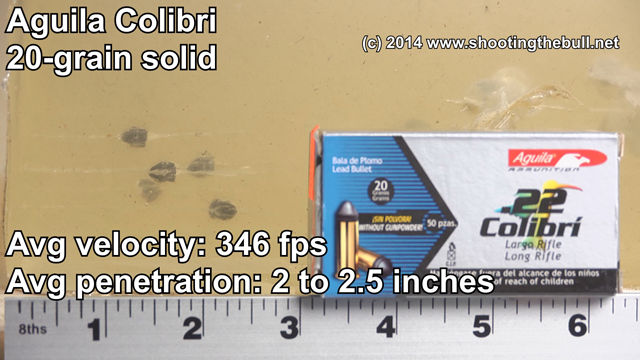

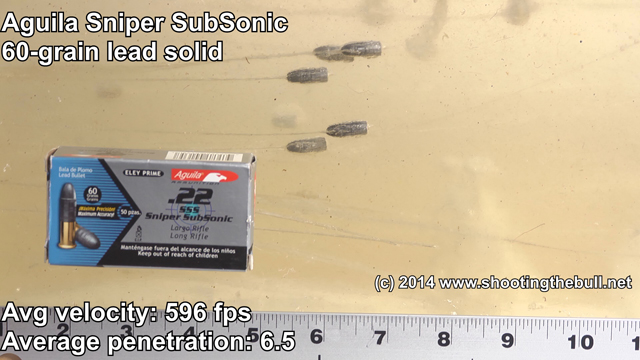
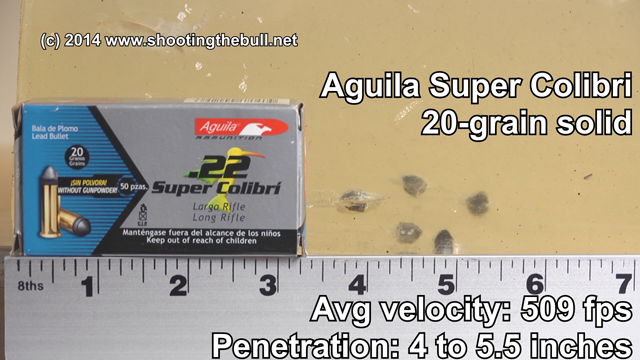
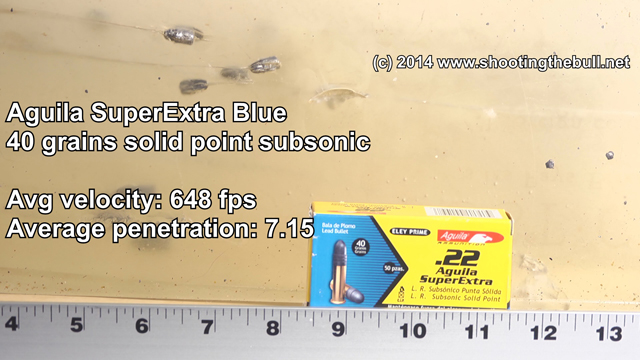
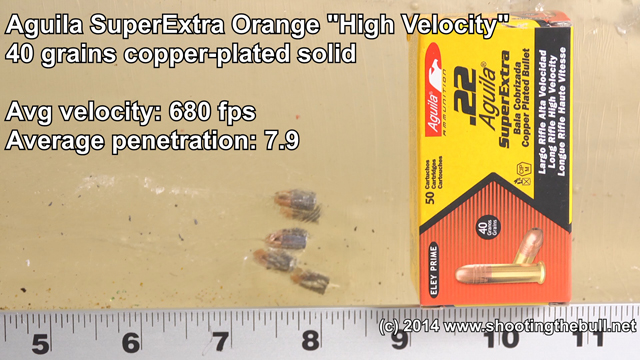
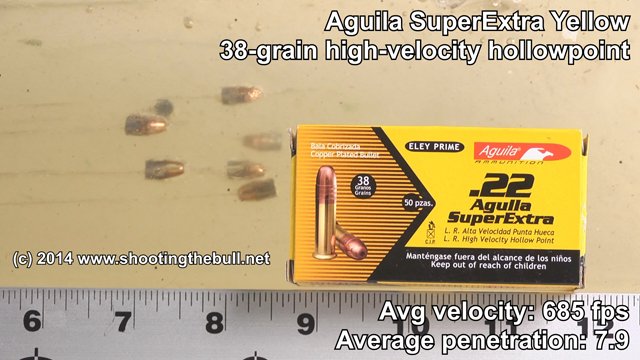
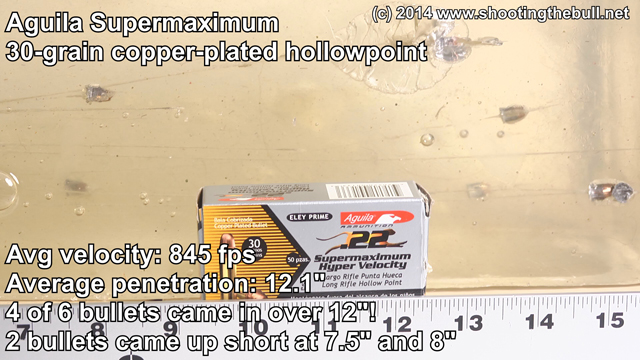
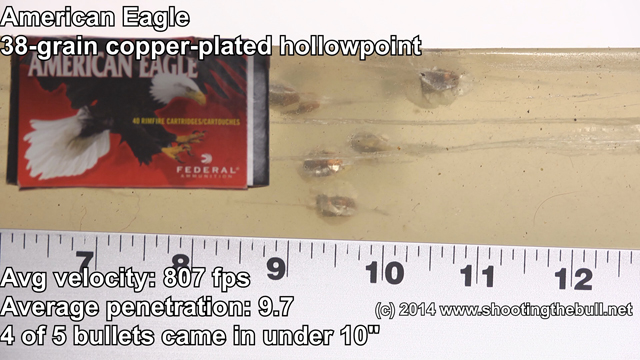
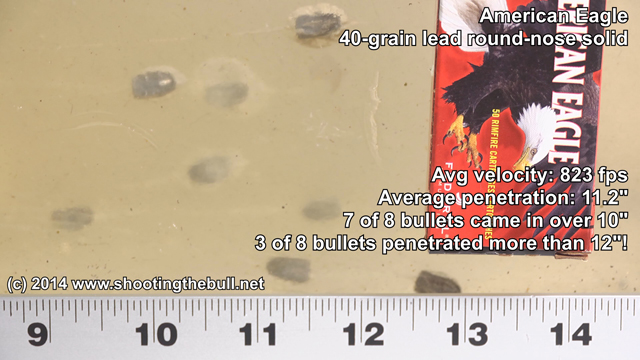
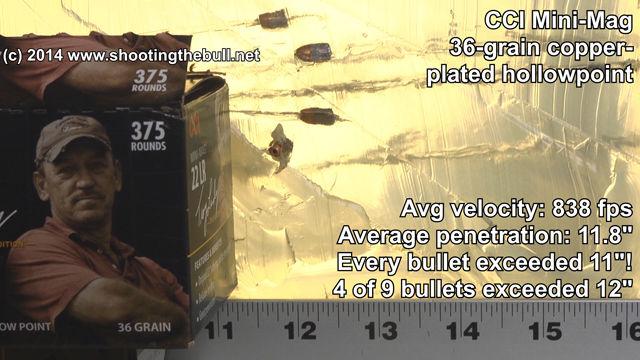
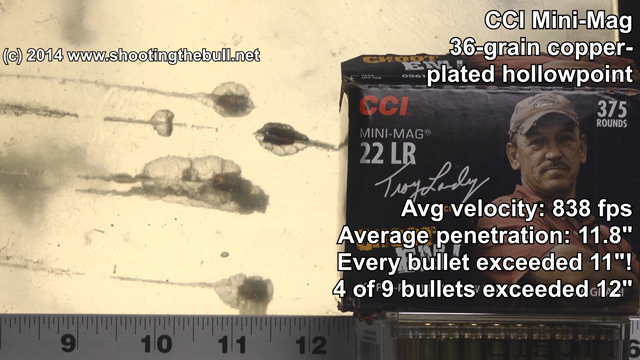
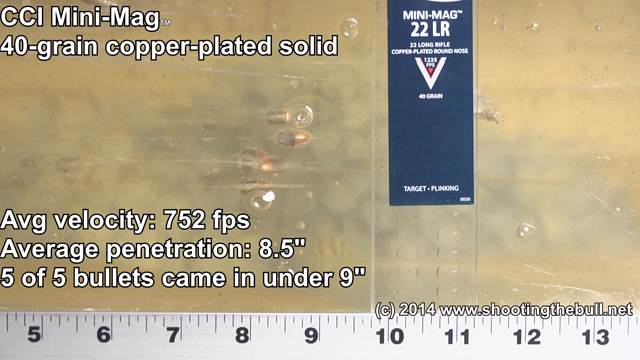
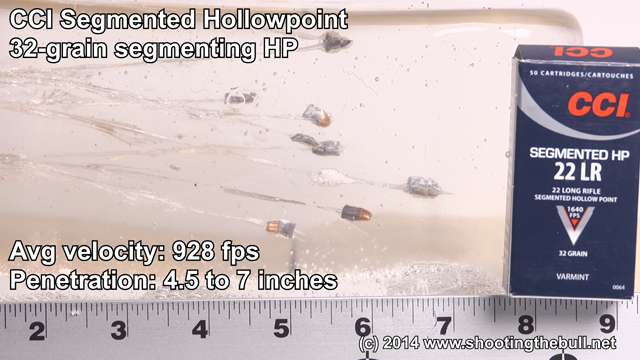
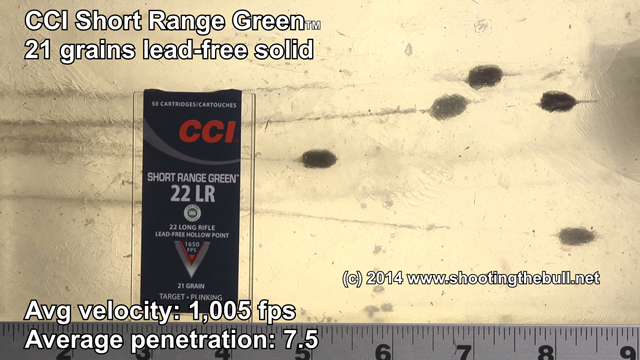

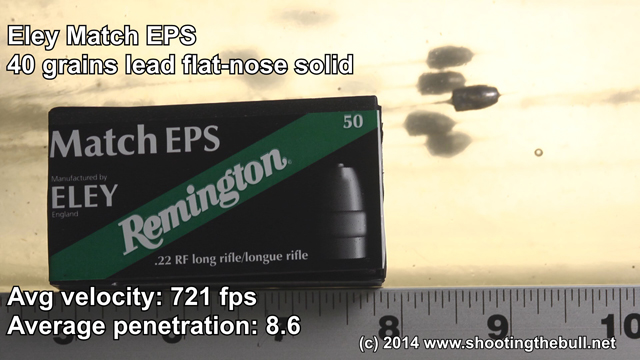
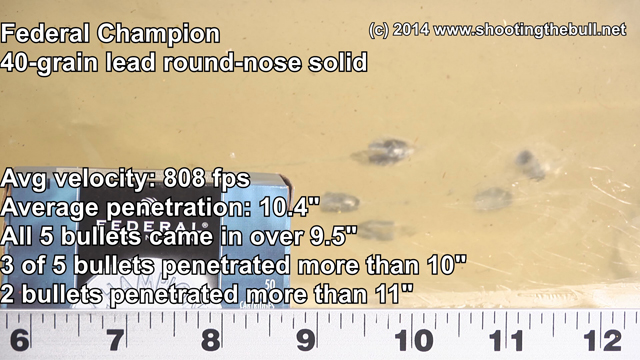
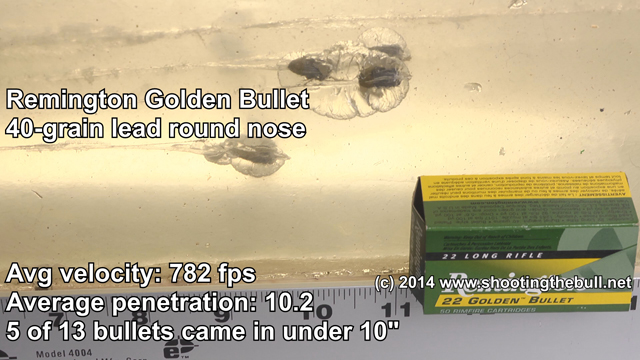
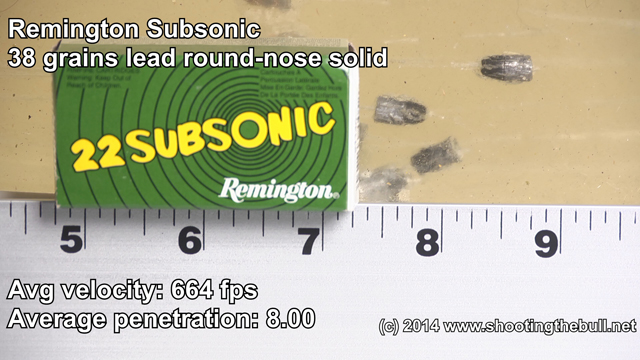
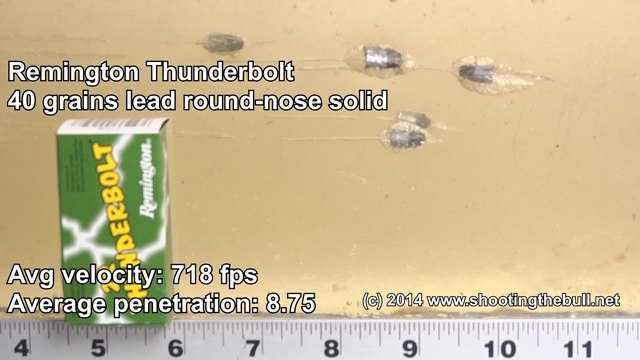
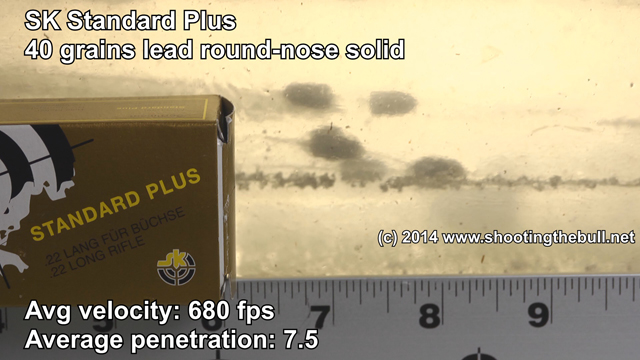
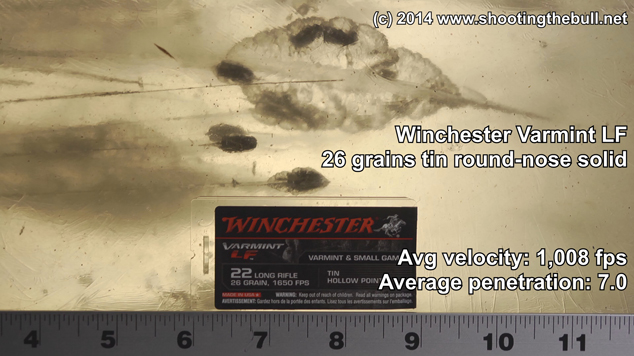
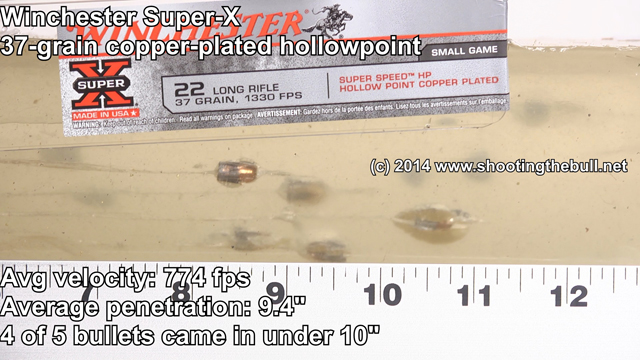
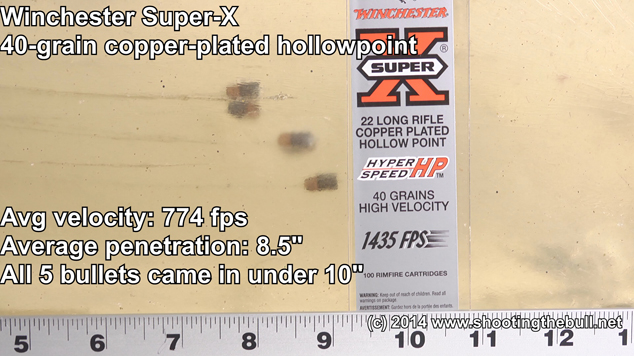
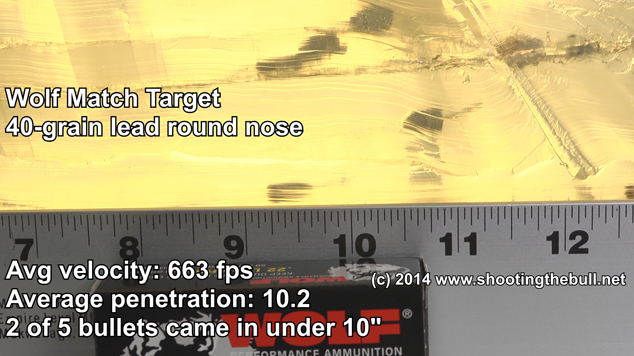

First one…. I suspect that you’d be better off firing blanks. 7.2 J is gonna do about as much as a high-end airsoft gun… Or a bike-pump pneumatic… Actually the bike pump weapon would be much more lethal, achieving 10 times the kinetic energy.
Not – high end air gun may exceed the FPS, but that itty bitty 14gr .177 pellet ain’t gonna poke much of a hole or penetrate worth a durn., methinks.
You have done the best ballistics testing on the internet by far. With your results, I have selected the best self defense ammo for my .380 and 9mm guns. I have several 22lr pistols and I like to have the best self defense ammo on hand for all of my guns. The 22lr is a little more difficult because there seems to be no consistency in velocity even in the premium brands. I found several tests of the CCI mini-mag 36gr HP in the NAA mini with very different results:
NorthAmericanArms – 708fps
BallisticsByTheInch – 723fps
ShootingTheBull – 838fps
I think you may have had an unusually hot loaded box for your test. In most tests the 36 gr HP is just slightly faster than the 40 gr solid. I have seem similar inconsistency in other brands and loads of 22lr, so my search continues for a round that performs consistently and penetrates adequately.
Yeah, I have no idea how to reconcile North American Arms’ testing. Their numbers are just way different.
With Ballistics By The Inch, I compared several loads I’ve tested against several that they listed, and consistently my numbers were quite a bit higher. Examples:
Aguila SSS: 596 vs 577
CCI Velocitor: 795 vs 767
CCI mini-mag 40gr solid: 752 vs 723
So, my numbers are consistently a little higher than theirs, but not overwhelmingly so. But they didn’t test the 40gr version of the mini-mag, so we can’t compare those directly. The 36-grain Mini Mags I tested were the “Troy Landry” version, and I tested them on several different occasions. In my testing, the average was 838 fps.
As for North American Arms’ own testing — their numbers are grossly below mine in every test, across the board.
Mini-mag 36gr: 832 vs 708
Mini-mag 40gr: 752 vs 681
Win Super-X 37gr HP: 811 vs 699
Win Super-X 40gr: 718 vs 685
Rem Thunderbolt 40gr: 718 vs 562
American Eagle 38gr: 807 vs 747
Aguila SuperMaximum: 845 vs 747
Aguila Super Colibri: 512 vs 451
Those are some pretty huge variations, but it’s consistently that my numbers were a lot faster than theirs. Maybe their guns had extremely tight barrels and mine has been shot through some, maybe we’re at wildly different elevations (In south Texas we’re at about 200 feet elevation; NAA is headquartered Provo, Utah at about 4,500 ft elevation). And, hey, Provo is a whole lot colder than south Texas, and temperature can have an effect. If they were testing outdoors in the middle of February in Provo at 18 degrees, and I was testing outdoors in south Houston at 90 degrees, you can expect some variation. Warmer air is less dense than colder air, so if they were shooting in cold temperatures and I shot the exact same round in warmer temperatures, you can expect that my results will be a little faster. How much faster? I haven’t found any definitive scientific data, but the ballpark seems to be about 2 fps per centigrade degree difference. So if they were at 0 degrees centigrade, and I was at 32 degrees centigrade, that could potentially account for up to 64 fps difference right there. However, I would expect the effect of temperature on fps would be a lot more relevant to ultra-high-speed rifle bullets (2,700+ fps) than it would be to ultra-low-speed handgun bullets (700-800 fps) so I wouldn’t expect the temperature difference to make THAT much difference.
Does anybody know how long ago NAA may have made there tests on 22lr ?
Maybe it is just one of those situations where all of those factors came together in such a way to produce very low velocities in the NAA testing and very high ones in your case.
I have a Taurus PT-22 ply and have been trying to find the best round for it. I found these results for the 36gr mini-mag which are all over the place also. There isn’t much out there for the PT-22ply yet, so I have used results from the Beretta 21A which has almost the same length barrel.
BallisticsByTheInch (Beretta 21A) 851fps
Gunblast(PT-22ply) 880fps
PocketGunsabdGear(Beretta 21A) 931fps
That is a considerable difference for the Beretta 21A
I found these for the Walther P22:
BrassFetcher 907fps
BallisticsByTheInch 967fps
I have noticed that the Aguila SSS has some pretty consistent results across a lot of testing, gradually increasing with barrel length from about 600fps to around 840fps with a 10″” barrel. After that, you don’t seem to get any more from longer barrels. That is a good round out of a 3-1/2″ or longer barrel.
Too bad the CCI Stingers and the Velocitor weren’t also tested, I think you would have found those to be good choices as well. I have seen 4LD gel tests with the Velocitors launched from a 2″ J frame where the bullet managed to get 14″ in the gel
Pingback: NAA 22 LR/22 Magnum Price | Buy & Sell NAA 22 LR/22 Magnum for FREE
Hi my friend have you tried cci stingers. I respect your testing and knowledge. I feel I should tell ya the stingers have a bit more penetration than the cci 32 gr mini mags. Please let me know what you think. Thanks brother.
I have tested ’em, and I’ll be updating my articles with the results at some point. They did well.
I’m interested to see the stinger results.
It looks like it’s been a long time since you commented that stinger results would be posted. Where can that be found?
In testing loands such as the CCI mini mags did you find it difficult to keep the mini revolver from moving up in your hand after every shot?
Highly difficult. It’s not easy to keep a grip on that thing no matter what. I love the small size, but the ergonomics are — well, let’s say they’re compromised. 🙂 The .22 magnum versions have a bigger grip and are a little easier to hold on to.
I don’t see Remington yellow jackets or vipers in any of your test & MORE IMPORTANT ..I don’t see CCI STINGERS OR VELOCITORS IN YOUR TEST..I IMAGINE most of us carry those two in our NAA minis ..would REALLY LOVE TO SEE TESTING ON THOSE IN SHORT BARREL NAA?
I am also very curious and a bit anxious to see the results you get from the CCI Stingers and Velocitors. Those are what I like to carry in my NAA mini revolver. I predict that they’ll both be top performers. I haven’t put a whole lot of either through my gun because they’re expensive and usually hard to find. In general, I think CCI makes a great product. Mini-Mags are one of my all time favorite .22 rounds. I read somewhere else that the Winchester 333/555’s did particularly well accuracy wise. I’m wondering if it would be possible for you to test those and the Winchester M-22’s and post the results. I have a fair amount of both in my stockpile. I also have a box of several hundred Winchester Dynapoints that have been sitting in my collection for some years now. In fact, so long that I’m not sure if they even make ’em anymore. Maybe they just don’t call them Dynapoints anymore. Anyway, thanks for all the time and effort you put into feeding our curiosity.
I can’t support a case for any of the ultra high velocity .22 LR ammo in an NAA mini. Most of it centers around ability to hold on to the gun when it fires. There’s just no way to get enough of a grip on the gun for that amount of recoil produced. Been there, done that. As far as “measuring” accuracy, that’s an exercise in fulility. There isn’t even a rear sight on a mini something I never understood why it has been and remains so. I’ve been tempted at times to get a laserlyte sight for mine, but I couldn’t rationalize that expense by raing a gun price by 50% in order to do so.
The .22 Magnum caliber in such a gun, almost any handgun for that matter is a waste of money. There’s plenty of ballistic evidence at this stage which supports my position. .22 Mag is a decent enough cartridge in a rifle, but even then there are more cost effective-for-result .22 upgrades such as .22 Hornet for that use. Hey, the U.S. military chose it years ago as a survival cartridge and we all know how fussy they are about making such choices. You can reload the .22 Hornet for little $ too.
The quest for bigger-is-better always results in these discussions. Keep it simple and just use good quality (reliable) ammo over bulk stuff, even standard velocity for that matter and you’ll be staying within parameters of comfort and controllability whenever (if ever) it’s needed for any fateful use.
I’ve been shooting for over 60 years starting before I was in first grade and have been a multi rating NRA Instructor for most of my adult life. I have the experience of seeing many newer-and-faster-is-better theories get debunked. Heck, I’ve done some of the debunking myself.
Joe
Definitely agree. With this mini revolver almost all of the extra gun powder from the magnum cartridge is burned off outside the barrel, thus such a large flame when firing and no real increase in velocity. I’ve called a couple rimfire manufacturers and both agreed that anything with a barrel less than 4 inches was not worth getting the magnum in as the difference, if any, was negligible.
I get a kick out of some people choosing to carry the NAA PUG. because it’s a .22 magnum.but with a one inch barrel. They loose so much velocity & energy .they might be just as well carrying the much smaller NAA MINI.22. With the longer nearly 2 inch barrel. & use much tamer .22 LONG rifle hyper vel stingers. .when I purchased my .22 Naa MINI it was for back up to a .38 snub, or to be used for deep hide out. Placed where no one could find it (like down in my sneaker..& in the crotch pouch of my BVD BREIFS )..LAST RESORT WHEN I COULDNT CARRY MY SNUB…THE MAGNUMS WERE MUCH TOO BIG for my use & my berretta .25 jet fire was same size as naa magnum & much,more desirable (9 shots fast ) NAA .magnum produces a lITTLE BETTER BALISTICS THAN.22 stinger but ONLY IF IT HAS LONGER 2″ barrel or over !
I’d like to see the results from .22 shorts. I realize shorts wouldn’t fit into your penetration goals, but it would still be interesting to see the results. I like shorts because of the lower recoil difficulty. Maybe sometime soon please? Thanks!
Pingback: NAA .22Lr for ccw? - Glock Forum
Given the nature and likely use of the mini, I’d be curious as to the penetration resulting from an actual contact shot – push it right up against the gel. Obviously you can’t measure velocity that way, but the penetration distance should be useful information.
I love all the little NA revolvers. I prefer the one with the LONGEST BARREL and a magnum/LR CONVERSION.
I’m wondering if some of the less than stellar loads you tested would fare better out of that 4 inch barrel!
Thanks a ton for going to the trouble to do all of this. This was exactly what I–and I’m sure countless others–have been looking for. Look forward to the update with stingers/velocitors.
Curious if anybody has ever done any testing from these guns using cci copper 22? I believe it is a 22gr copper polymer round delivering ~1600fps.
What a great review, I am going to watch and subscribe to the video as well! I have the NAA that folds into it’s own little holster. Love it! I bought the .22 WMR cylinder but would prefer to use the .22 LR because I have plenty of other .22 WMR pistols that are harmful to your ears when you shoot them without ear pro (doing it once was enough). I don’t think the hearing damage will be worth the extra couple of inches of penetration. I had CCI mini mag hollow points in mine before I read this and feel even better about that choice now. They are my go too all purpose round if I am not using a suppressor! For suppressor use I love the CCI segmented subsonic. It has been very terminal on small and “medium” game.
Being a NAA Fan boy it’s better then using a pen. I like the fit and finish dm near perfect. Also like the fact there so different and fun to shoot. I have a LR with 5000 plus rounds thru no it wasn’t just me my hand could not take that it was the family which all love Shooting it.
Thanks so much for doing such a great discovery. I enjoyed reading it.